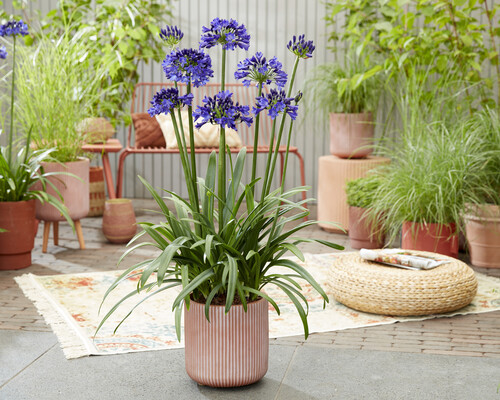Unleashing the Secret to Effective Agapanthus Growing: Idea for a Flourishing Yard
In the realm of gardening, cultivating agapanthus effectively requires a calculated method that encompasses different facets of plant care. By comprehending the subtleties of agapanthus cultivation, one can create a setting where these plants prosper and grow generously.
Planting Agapanthus: Finest Practices
When growing Agapanthus, proper soil prep work is important for making certain effective growth and development of these beautiful blossoms. Agapanthus, frequently referred to as Lily of the Nile or African lily, thrives in well-draining soil with a slightly acidic to neutral pH level - Agapanthus. Prior to planting, it is essential to change hefty clay soils with organic issue such as compost or peat moss to enhance water drainage and provide vital nutrients for the plants
To grow Agapanthus, select a place that gets complete sunlight to partial shade, as this will promote healthy growth and plentiful blooming. Dig a hole two times the diameter of the plant's root ball and place the Agapanthus at the same deepness it was formerly growing. Gently backfill the hole with dirt, pushing down firmly to get rid of any air pockets around the origins.
Water the recently grown Agapanthus completely and proceed to keep the soil uniformly moist, especially throughout the plant's energetic expanding period. Agapanthus. Using a balanced plant food once a month can further sustain the plant's growth and flowering. By following these finest practices for planting Agapanthus, you can produce a sensational display screen of these captivating blossoms in your garden
Perfect Soil Conditions for Agapanthus
For ideal development and growing success of Agapanthus plants, ensuring the dirt conditions are ideal is vital. Agapanthus likes dirt that is rich in nutrients, so integrating a balanced plant food throughout the growing period can advertise healthy development and vibrant flowers.

Watering and Fertilizing Tips
To guarantee healthy and balanced growth and vivid blossoms, appropriate watering and fertilizing methods are essential for successful Agapanthus cultivation. Agapanthus plants profit from routine watering, specifically during the expanding period.
When it involves fertilizing Agapanthus, a well balanced fertilizer with equivalent parts nitrogen, phosphorus, and potassium can be used in the springtime to promote healthy and balanced development and blooming. Slow-release fertilizers are ideal for providing nutrients progressively over an extended duration. Prevent over-fertilizing, as this can lead to excessive vegetation development at the cost of flowers.
Additionally, incorporating raw material like compost into the soil can enhance nutrient levels and enhance soil structure, helping in the general wellness of the Agapanthus plants. By following these watering and fertilizing tips, gardeners can ensure their Agapanthus plants grow and generate spectacular screens of flowers.
Trimming and Deadheading Techniques
Proper pruning and deadheading methods play an important duty in preserving the health and appearances of Agapanthus plants, enhancing the essential methods of watering and fertilizing for effective growing. Pruning Agapanthus involves eliminating spent blossom heads, yellowing or dead leaves, and overall shaping of the plant to promote much better development. Deadheading, the procedure of getting rid of faded flowers, find out here now not only improves the plant's appearance however additionally encourages additional flowering.
When deadheading Agapanthus, it is a good idea to clip off the blossom stem at the base using sharp, clean shears. This procedure reroutes the plant's power from seed production back right into origin and foliage development, advertising a healthier and a lot more robust plant. Regular deadheading can extend the growing duration of Agapanthus and protect against self-seeding, which can lead to congestion.
In terms of pruning, Agapanthus generally advantages from a light trim after flowering to tidy up the plant and urge fresh development. Reducing back the spent blossom stems and eliminating any kind of dead or broken vegetation aids keep the plant's vigor and total look. However, it is vital to avoid cutting into the crown of the plant, as this can compromise its wellness.

Protecting Agapanthus From Vermins and Diseases
Executing reliable insect and condition administration techniques is important to guarding the health and wellness and vigor of Agapanthus plants in cultivation. One common parasite that influences Agapanthus is the Agapanthus borer, a caterpillar that tunnels right into the plant, creating damages to browse this site the leaves and flowers.
Along with insects, Agapanthus are at risk to conditions such as origin rot and fungal fallen leave areas. These issues can frequently be protected against by making sure proper water drainage and avoiding overwatering. Affected components of the plant must be promptly eliminated to avoid additional spread if signs of illness appear. Fungicides may also be made use of as a treatment action, following the manufacturer's instructions very carefully. By staying alert and resolving bug and illness issues without delay, gardeners can assist their Agapanthus thrive and grow.

Final Thought
Finally, effective growing of agapanthus needs correct growing strategies, perfect dirt conditions, sufficient watering and feeding, regular pruning and deadheading, and defense from parasites and diseases. By complying with these pointers and methods, garden enthusiasts can ensure a prospering yard loaded with beautiful agapanthus blooms. Agapanthus. Remember to preserve consistent care and interest to information to advertise the more tips here health and longevity of these stunning plants
When planting Agapanthus, proper dirt prep work is necessary for making sure successful growth and development of these attractive blossoms.Water the recently planted Agapanthus completely and proceed to keep the soil evenly damp, specifically during the plant's active expanding season.For optimal growth and growing success of Agapanthus plants, making sure the dirt conditions are excellent is crucial. When hair transplanting or growing Agapanthus, guarantee the soil is well-prepared to offer the required foundation for the plants to establish themselves effectively. One common bug that influences Agapanthus is the Agapanthus borer, a caterpillar that tunnels right into the plant, triggering damage to the fallen leaves and blossoms.
Comments on “Growing Agapanthus: A Full Overview to Beautiful Blooms”